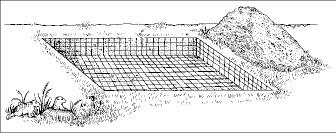Vegetable Gardening (124 page)

 Cats and dogs:
Cats and dogs:
Fences work best to keep four-legged friends — and your neighbors — out of your garden. Cats are a problem early in the season when they like to dig in newly tilled ground; laying chicken wire, pruned rose or raspberry canes, or hardware cloth over your seedbed until plants sprout encourages cats to dig elsewhere. Try spraying a pepper and garlic spray (see the earlier section "Methods of attack" for details) to deter these critters.
 Deer:
Deer:
A slanted fence can keep Bambi and her fawns out of your garden. Their instinct is to try to crawl under a fence before jumping it, and they're less likely to jump a wide fence. A slanted fence can be 4 to 5 feet high (see Figure 17-5); a vertical fence must be at least 8 feet high to keep deer from jumping over it.
 Gophers:
Gophers:
Gophers can wreak havoc by eating plants' roots and underground parts. Trapping is the most practical solution in most cases. Probe the soil near a fresh mound of dirt with a crowbar, and set two traps in the runway, one facing each direction. Tie the traps together and cover them lightly with soil to keep out light.
Figure 17-5:
A slanted fence is the best design to keep deer out of your garden.
If your garden is small or organized into small beds, you may want to construct a gopher barrier, as shown in Figure 17-6. Dig the soil out of the bed to a depth of at least 12 inches and line the bottom and sides with 1-inch chicken wire. Then replace the soil.
 Mice and small rodents:
Mice and small rodents:
A 12-inch-high fence made of 1/4-inch mesh hardware cloth, with another 12 inches buried underground, keeps mice and other small rodents out of your garden.
Figure 17-6:
Fencing is the safest and most effective way to deter digging animals like gophers.
 Moles:
Moles:
Moles don't feed on plants; they eat insects such as grubs and earthworms. However, their tunneling may damage the roots of your plants. The most effective way to control moles is to repel them. Moles don't like the smell of castor oil, so spray a mole repellent, such as Mole Med, that contains castor oil.
 If the problem is severe, set traps in the tunnels. To find active tunnels, tamp down raised soil, which indicates tunneling. The tunnels that are raised the day after you tamp the soil are active.
If the problem is severe, set traps in the tunnels. To find active tunnels, tamp down raised soil, which indicates tunneling. The tunnels that are raised the day after you tamp the soil are active.
 Rabbits:
Rabbits:
A 2-foot-high fence made of 1 1/2-inch mesh should keep rabbits out of your garden. Make sure the bottom is tight to the ground or bury the bottom edge as recommended for woodchucks. You also can try a pepper and garlic spray designed to repel cats and dogs.
 Raccoons:
Raccoons:
A 4-foot-high fence similar to the one recommended for woodchucks usually keeps raccoons out of your garden.
 Woodchucks:
Woodchucks:
A fence at least 3 feet high with another 12 inches underground, curved away from the garden, is the best way to keep out woodchucks, also known as groundhogs (see Figure 17-7). Leave the top 18 inches of the fence unattached to support posts. This way, as the woodchuck attempts to climb over the fence, the fence will bend back down under the animal's weight. A strand of electric wire on top of a wire fence also discourages them.


